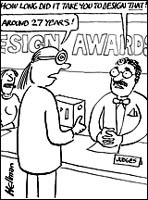Time for a closer look
There’s more to good design than pleasing aesthetics. Isn’t it time awards judges asked how well a design works, rather than how good it looks?

Once upon a time lots of creative people left art school and decided that they wanted to be artists. However, they wanted to drive an MG and live in Chelsea, so they became designers instead.
Business people thought the designers’ visual flair could help them shift more gear and lavished great riches on them (well, they paid their invoices at least). Congratulating themselves over lunch one day, the great and good of this growing industry decided that it was time to create a way to celebrate what they were doing.
Designers up and down the land were asked to send in their best work and the great and good spent an afternoon looking at them, mulling them over while puffing on a cigar and deciding which of the pieces were the prettiest and deserved to be given fine ribbons and a laminated certificate.
Lo and behold, design awards were born, and many years of judging and ribbon-giving have followed.
Over that time the best award schemes have consistently finessed how the work submitted is judged. It took the DBA Design Effectiveness Awards to shake up the basic model, but the creative gong shows have done a fair job of improving the sophistication and relevance of the judging criteria and processes.
But design awards (DEA aside, perhaps) are now entering a difficult phase. Their problem is that they used to lead the industry. They were part of a virtuous circle in which the “best” work was highlighted, thereby encouraging the pursuit of “better” work throughout the industry (and more entries the following year). What’s more – in an industry that too often locks itself away in the studio – they were a valuable exercise in community building.
However, once at the forefront, design awards are now running breathlessly behind in an industry that is reinventing itself at the speed of a single byte down an ADSL line. Today, much of the most important work carried out by designers is visually and materially intangible and a lot of the most profound thinking is not necessarily directly to do with creating a simple-to-assess visual solution. What’s more, many of the most important projects are complicated beasts that cannot be simply judged on a 30-second glance in the judging room. Take branding: how do you gauge the specific value of a brand development team’s work on a particular project? Do you assess their research results? Their thousands of discussions and idea generation meetings? The time spent in the bath thinking around an issue? Sure, you could look at the printed work that develops as a result of their branding skills, but that would be to reduce their activity to a very trite level. Besides, there are plenty of projects where the branding work is excellent, but the specific graphic executions are poor. So it is difficult to judge the activity of branding, and yet the words brand or branding form the basis of many a design company’s offer to the world.
Take another example – website programming. I have met HTML and Java programmers who care as much about the aesthetics of their code as a graphic designer does their work. A bit of numerical fluff is as ugly to them as a badly scanned image is to their graphic cousins. What’s more, if the code is ugly it often means it doesn’t function as effectively. Sounds familiar, and yet how do you judge excellent creative programming? Will judges in the interactive categories of the future have time to look at the mathematical constructions lying beneath the screen surface?
Other examples could be user interaction analysts, market researchers, even account directors – the list of “intangible” workers goes on. Yet, this is not an argument for the abolition of creative award schemes in the design industry. In fact, I think as a community we need more shared experiences. But it is no longer enough for awards to simply bring a panel of people together to give a bunch of work the once over and award a gong. We need to see a radical re-evaluation of how work is entered, including the length of time given to assessing entries. We need to see a commitment to more contextual information. And we need to see brave steps taken to incorporate areas of design activity – such as brand development or programming – that are difficult to assess. It will only be through engaging fully with a new, more complex and fast-changing design world that design awards will retain their value within our community.
No one sets much store by beauty parades any more, do they?
-
Post a comment




